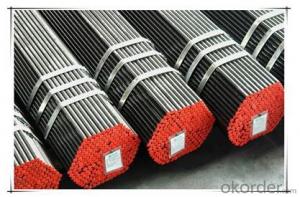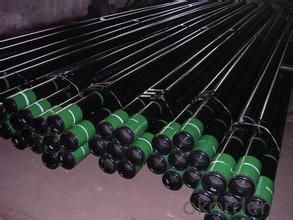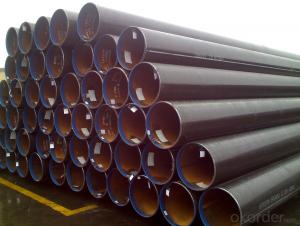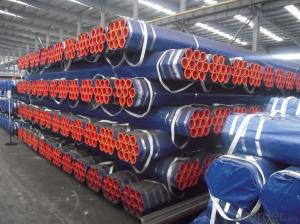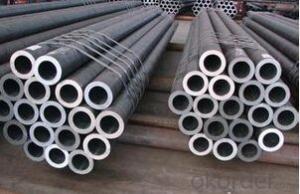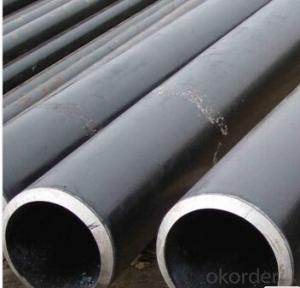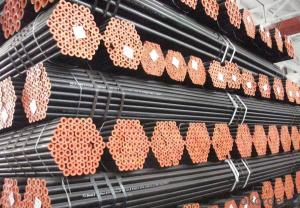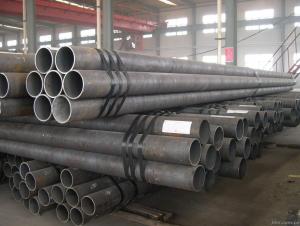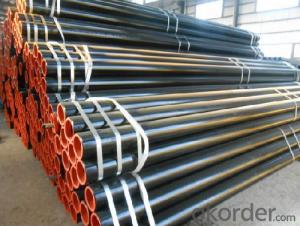Low and Medium Pressure Boiler Tube Seamless Steel Pipe
- Loading Port:
- China main port
- Payment Terms:
- TT or LC
- Min Order Qty:
- 25 m.t.
- Supply Capability:
- 10000 m.t./month
OKorder Service Pledge
OKorder Financial Service
You Might Also Like
LOW AND MEDIUM PRESSURE BOILER STEEL PIPE
NO | STEEL GRADE | SPECIFICATION | NORMAL | ||
OD/mm | WT/mm | LENGTH/m | |||
1 | 10、20 | 48~114 114~340 | 4~16 4.5~36 | 6~12.2 6~15 | GB3087 |
Specifications
Seamless steel tubes for low and medium pressure boiler
1)Size: 19mm-2200mm
2)Standards: ASTM,DIN,JIS,G3463
Seamless steel pipe is kind of hollow section, with no seams around, round, square, or rectangular strip steel. Seamless steel pipe is made from ingot steel, or hollow billet that perforated through solid pipe, then hot rolled and cold rolled or cold drawn.
Standard and Grade
GB/T3087-2008(Seamless steel tubes for low and medium pressure boiler):
Mainly used in industrial boiler and boiler of low intermediate pressure fluid pipe. Material: 10#, 20#.
Length Fixed: 3.0 , 5.8 , 5.85 , 5.9 , 6.0 ,11.8 , 12.0m. Random length: 5-12m
Surface Black painting, varnish paint, anti rust oil, hot galvanized, cold galvanized, 3PE,etc.
Certificate ISO9001, SGS,BV, etc
Package Plastic caps on both ends, Steel bundle, Woven bag or acc. to customers' request
FAQ of Low and Medium Pressure Boiler Tube Seamless Steel Pipe:
①How is the quality of your products?
Our products are manufactured strictly according to national and internaional standard, and we take a test on every pipe before delivered out. If you want see our quality certifications and all kinds of testing report, please just ask us for it.
Guaranteed: If products’ quality don’t accord to discription as we give or the promise before you place order, we promise 100% refund.
②How about price?
Yes, we are factory and be able to give you lowest price below market one, and we have a policy that “ for saving time and absolutely honest business attitude, we quote as lowest as possible for any customer, and discount can be given according to quantity”,if you like bargain and factory price is not low enough as you think, just don’t waste your time.Please trust the quotation we would give you, it is professional one.
③Why should you chose us?
Chose happens because of quality, then price, We can give you both.Additionally, we can also offer professional products inquiry, products knowledge train(for agents), smooth goods delivery, exellent customer solution proposals.Our service formula: good quality+good price+good service=customer’s trust
SGS test is available, customer inspection before shipping is welcome, third party inspection is no problem.
Any question, pls feel free to contact us !
Low and Medium Pressure Boiler Tube Seamless Steel Pipe Images
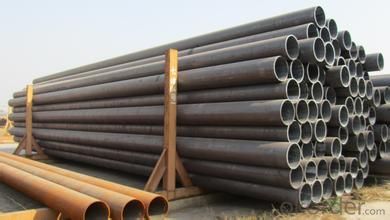
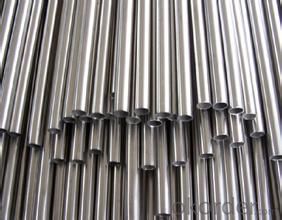
- Q: Are steel pipes suitable for underground industrial waste disposal?
- Yes, steel pipes are generally suitable for underground industrial waste disposal. Steel pipes are durable, resistant to corrosion, and can withstand high pressure, making them a reliable choice for transporting and disposing of industrial waste underground. Additionally, steel pipes have a long lifespan and can be easily maintained, reducing the risk of leaks or contamination.
- Q: How are steel pipes cleaned and maintained?
- Steel pipes are cleaned and maintained through various methods. The process typically involves removing any debris or rust from the pipes using wire brushes or sandblasting. After cleaning, a protective coating is applied to prevent corrosion. Regular inspections and maintenance checks are also conducted to identify any potential issues such as leaks or weak points, ensuring the pipes remain in optimal condition.
- Q: Can steel pipes be used for underground cable ducting?
- Yes, steel pipes can be used for underground cable ducting. Steel pipes are commonly used for underground cable ducting due to their durability and strength. They provide a protective casing for the cables, preventing damage from external factors such as moisture, pressure, and environmental elements. Steel pipes are also resistant to corrosion, which makes them a suitable choice for long-term use underground. Additionally, steel pipes can withstand heavy loads, making them ideal for areas where cables may be subjected to high pressure or weight. However, it is important to consider factors such as soil conditions, installation requirements, and the specific needs of the cable system before choosing steel pipes for underground cable ducting.
- Q: How are steel pipes used in the water supply system?
- Steel pipes are used in the water supply system to transport and distribute water efficiently and safely. They are durable, corrosion-resistant, and have a high carrying capacity, making them ideal for transporting large volumes of water over long distances. Steel pipes are commonly used for mains and transmission lines in water supply networks, ensuring a reliable and steady water flow to homes, businesses, and industries.
- Q: What is the difference between steel pipes and FRP pipes?
- Steel pipes and FRP pipes are commonly used in various industries and applications, but they differ in several ways: 1. Material Composition: Steel pipes are constructed from iron and carbon alloys, along with elements like manganese, silicon, and small amounts of other metals. Conversely, FRP pipes consist of a polymer matrix reinforced with fibers such as glass or carbon. 2. Strength and Durability: Steel pipes are renowned for their exceptional strength and durability, enabling them to endure high pressures, heavy loads, and extreme temperatures. Although FRP pipes are also strong and durable, they are comparatively lighter in weight and may not possess the same level of strength as steel pipes. Nonetheless, they excel in corrosion resistance and have a longer lifespan in corrosive environments. 3. Corrosion Resistance: Steel pipes are susceptible to corrosion and thus require protective coatings or linings to prevent rust and deterioration. In contrast, FRP pipes possess inherent corrosion resistance and do not necessitate additional coatings. Consequently, they are well-suited for transporting corrosive fluids or functioning in corrosive environments. 4. Installation and Maintenance: Installing steel pipes necessitates specialized welding or threading techniques. Consequently, installation can be more labor-intensive and time-consuming, particularly for complex or large-scale projects. Conversely, FRP pipes are lightweight and easily transportable and installed. Often arriving in pre-fabricated sections, they expedite installation, reduce labor requirements, and demand minimal maintenance in comparison to steel pipes. 5. Cost: Generally, steel pipes are more expensive than FRP pipes due to the higher cost of raw materials and the need for additional corrosion protection measures. FRP pipes offer a cost-effective alternative, particularly in applications where corrosion resistance is paramount, as they eliminate the necessity for expensive coatings or linings. Ultimately, the selection between steel pipes and FRP pipes depends on the specific requirements of the application. Steel pipes are favored for their high strength, whereas FRP pipes offer advantages such as corrosion resistance, lightweight construction, and cost-effectiveness.
- Q: How do you measure the thickness of steel pipes?
- To measure the thickness of steel pipes, you can use various methods depending on the level of accuracy required. One commonly used method is the ultrasonic measurement technique. Ultrasonic measurement involves using an ultrasonic thickness gauge, which emits high-frequency sound waves that travel through the pipe walls and bounce back to the gauge. The time it takes for the sound waves to travel through the pipe and return provides an accurate measurement of the thickness. This method is non-destructive and can be used on both ferrous and non-ferrous materials. Another method is the use of calipers or micrometers. This involves manually measuring the outside diameter (OD) and inside diameter (ID) of the pipe and then subtracting the ID from the OD to obtain the thickness. However, this method is less accurate compared to ultrasonic measurement. In some cases, where precision is not critical, a simple tape measure or ruler can be used to measure the outside diameter of the pipe. The thickness can then be estimated by referring to standard pipe thickness charts or tables. It is important to note that measuring the thickness of steel pipes accurately is crucial for various applications such as construction, manufacturing, and engineering. Therefore, it is recommended to use appropriate measuring tools and techniques to ensure accurate results.
- Q: How are steel pipes used in the construction of railway tracks?
- Steel pipes are used in the construction of railway tracks as they provide a strong and durable foundation. They are typically used for the support and reinforcement of the tracks, helping to distribute the weight of the trains and ensuring stability. Steel pipes also play a crucial role in drainage systems, allowing for proper water flow and preventing damage to the tracks.
- Q: What is the difference between steel pipe and concrete pipe?
- Steel pipe and concrete pipe are both commonly used for various applications, but they differ significantly in their material composition and properties. Firstly, the main difference lies in the materials used to manufacture these pipes. Steel pipes are made from steel, which is an alloy of iron and carbon. On the other hand, concrete pipes are made from a mixture of cement, aggregate (such as sand or gravel), and water. Secondly, steel pipes are known for their strength and durability. They can withstand high pressure, making them suitable for applications that require transporting fluids or gases under high pressure. Steel pipes also have a high resistance to corrosion, which is advantageous in environments where the pipe is exposed to moisture or chemicals. In contrast, concrete pipes are not as strong as steel pipes and are more prone to cracking or damage under high pressure. However, they are still capable of handling moderate pressure loads and are often used for drainage systems or sewage applications. Another significant difference is the installation process. Steel pipes are typically joined together using welding techniques, such as butt welding or socket welding. This creates a seamless and strong connection between the pipes. On the other hand, concrete pipes are often installed using rubber or gasketed joints, which are easier to assemble and disassemble. Cost is another factor where steel and concrete pipes differ. Steel pipes tend to be more expensive due to the higher cost of steel as a raw material and the additional labor required for welding and fabrication. Concrete pipes, on the other hand, are generally more cost-effective as the materials used in their production are more readily available and the installation process is simpler. In summary, the main differences between steel pipes and concrete pipes lie in their material composition, strength, resistance to corrosion, installation process, and cost. Steel pipes offer superior strength and durability, making them suitable for high-pressure applications and environments prone to corrosion. Concrete pipes, while not as strong, are cost-effective and commonly used for drainage systems or sewage applications.
- Q: What's wrong with the 3PP anticorrosive steel tube?
- That is, polypropylene corrosion resistant coating of steel pipe, the biggest feature of this anti-corrosion coating is good heat resistance.
- Q: How are steel pipes made?
- Steel pipes are made through a process called pipe manufacturing, which involves multiple steps. Firstly, raw steel is melted in a furnace and then subjected to continuous casting to form a solid billet. This billet is then heated and pierced to create a hollow tube called a shell. Next, the shell is rolled and stretched to the desired diameter and thickness using a series of rollers. The pipe is then subjected to a process called welding, where two edges of the shell are fused together to create a seamless or welded pipe. Finally, the pipe undergoes various finishing processes such as cutting, straightening, and inspection before being ready for use.
Send your message to us
Low and Medium Pressure Boiler Tube Seamless Steel Pipe
- Loading Port:
- China main port
- Payment Terms:
- TT or LC
- Min Order Qty:
- 25 m.t.
- Supply Capability:
- 10000 m.t./month
OKorder Service Pledge
OKorder Financial Service
Similar products
Hot products
Hot Searches
Related keywords
